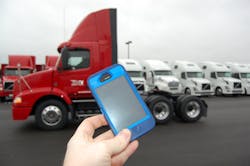From route analysis to fuel economy performance programs, technology is rapidly being seen as a critical lever to growing profits for trucking companies large and small – even for businesses that don’t haul freight for a living.
“The tremendous benefit of technology is that it allows fleets to generate more profit from data,” explained Joel Clum, co-founder and president consulting firm Carrier Direct, in a conference call organized by Wall Street investment firm Stifel, Nicolaus & Co. last week. “It allows for better costing, pricing, and hauling models.”
Clum believes that LTL carriers are in a better position to drive the benefits of technology across their segment of the trucking industry simply because the largest carriers control the biggest portion of the market: the top six carriers handle more than 50% of LTL freight today with the top 10 handling 70%.
By contrast, 34 years after deregulation, the TL industry remains in his words “remarkably fragmented” as the top carriers still represents less than 1% market share, Clum said.
“As a result, there are few clear leaders in the industry that are willing to take the decisive actions that, if done systemically, would be good for the industry as a whole,” Clum emphasized. “The fear on behalf of the individual [TL] carriers is that the risks associated with being an early adopter, innovator, or advocate come with potentially severe penalties” such loss of freight and profits.
Yet many TL carriers continue to tap into a variety of technologies if not to boost freight profits than to help reduce operating expenses. Doug Shrier, senior VP of continuous improvement at Covenant Transport, told Fleet Owner by email that his company implemented the FuelOpps program developed by Propel IT to help boost fuel economy because Covenant “actively pursues excellence in all areas of the business to benefit our drivers, shareholders and all stakeholders.”
He noted that miles per gallon is a key performance indicator (KPI) in trucking therefore a focus for Covenant’s team. “A 1/10th a mile improvement represents almost a penny in cost per mile and an opportunity to be better,” he explained.
“We chose Fuel Opps for several reasons,” Shrier said. “This program provides great benefits to the driver while not being another distraction in the cab; the driver benefits by receives updates on their performance frequently and they can check their scores daily; the program also provides positive recognition, completion and positive coaching to our driver by dedicated resources; and finally the program focuses on behaviors that the driver has 100% control over.”
Even the use of smartphones to manage operations is rapidly increasing in trucking, with a 2012 survey conducted by GreenRoad finding that fleet managers at 76% of the carriers it polled now carry smartphones at work, with 59% using smartphone or mobile apps for fleet management purposes – a more than threefold increase in just seven months at the time, when only 19% reported using fleet management apps.
Yet many fleets large and small alike are still waiting on the sidelines when it comes to adopting various technologies. For example, Joe Castelli, VP of fleet and commercial operations for LoJack Corp., noted that roughly only 20% of fleet vehicles in the U.S. have adopted telematics systems to date.
“That fact that 80% of the market remains untapped in terms of the advantages of telematics is actually pretty exciting; that’s a huge opportunity,” he explained to Fleet Owner in an interview. “And the primary ‘asset tracking’ purpose of telematics is really only the tip of the iceberg in terms of what the technology can do to improve operations.”
As telematics systems are being increasingly connected to “real-time” traffic data providers – LoJack, for example, partners with TomTom to provide its customers with such information – fleets are only gaining the ability to re-route vehicles around roadway congestion, not only saving fuel but preserving delivery times for customers as well as work hours for employees.
“Fuel consumption and maintenance alone are 30% of the total cost of owning a fleet vehicle, so anything data-wise you can do to help in those areas – reduce idle time, optimize routes, plan downtime for maintenance – the more money a fleet can save,” Castelli said.
“And now when you add in geofencing capability as well as the ability to send all of this data to a smartphone or tablet so a fleet manager can access it anywhere they are, day or night, now you have visibility and control of fleet operations that didn’t exist before,” he stressed.
Carrier Direct’s Clum noted that in terms of profitability, this is the kind of data that will help trucking companies separate ‘”bad” from “good” freight in their networks.
“The long term investment case is bullish for TL carriers, LTL carriers, and 3PL [third party logistics] providers,” he said.
As regulations sap TL capacity, the carriers best able to cope will be most able to proactively select the customers they wish to do business with, focus on their balanced “power lanes,” and maximize their margins, Clum noted.
“LTL carriers currently have ample demand to maximize their capacity utilization with plenty of freight. The challenge for these carriers is to determine how to currently optimize profits by making tradeoff decisions between more and less profitable freight,” he stressed.
“LTL carriers will benefit from the implementation of systems supporting improved decision making and improved pricing,” Clum added. “In addition, they will benefit from the near-shoring and in-sourcing mega-trend given that they are best positioned to handle parts, components, and sub-assemblies that must be moved as more manufacturing comes [back] to North America.”
About the Author
Sean Kilcarr
Editor in Chief
Sean Kilcarr is a former longtime FleetOwner senior editor who wrote for the publication from 2000 to 2018. He served as editor-in-chief from 2017 to 2018.
